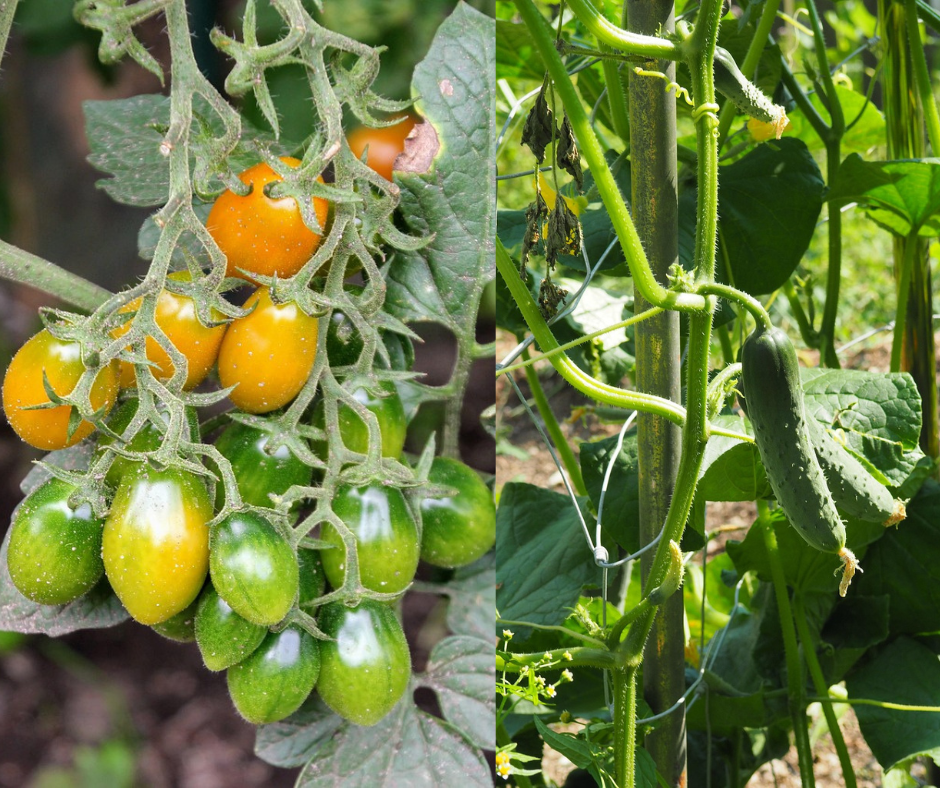
Imagine a lush, vibrant garden where tomatoes and cucumbers thrive side by side, their intertwined roots and leaves creating a symphony of green. However, this harmonious scene is not without its challenges. In this enlightening exploration, we’ll go into the intricacies of growing these two beloved vegetables together, highlighting the unique obstacles that await the ambitious gardener.
This post may have affiliate links. This means that sometimes when you click a link on our site and make a purchase on Amazon, we may earn a small commission at no additional cost to you. We only recommend products we truly believe in, and your support helps keep us running!
Challenge 1: Sunlight and Space
Tomato’s Sun-Loving Ways:
- Photosynthesis Powerhouse: Tomatoes, like solar panels, need sunlight to fuel their growth and fruit production. Aim for at least 6 hours of direct sunlight daily for optimal performance.
- Shade Sensitivity: Too little sun can lead to weak, leggy plants, delayed ripening, and even blossom end rot (calcium deficiency).
Cucumber’s Shade Tolerance:
- Partial Shade Friend: Unlike tomatoes, cucumbers can tolerate partial shade (4-6 hours of direct sun), especially during the hottest part of the day. This makes them ideal for planting beneath taller plants or in areas with afternoon shade.
- Sunburn Risk: However, excessive direct sun can scorch cucumber leaves and hinder growth.
Finding the Balance:
- Vertical Layering: Utilize trellis or cages for tomatoes, allowing cucumber vines to sprawl underneath. This creates a layered canopy, providing shade for cucumbers while maximizing sunlight for tomatoes.
- Morning Sun, Afternoon Shade: Choose a location with morning sun for both plants, as it’s gentler than afternoon sun. Provide afternoon shade for cucumbers with taller plants, shade cloth, or strategic planting.
- Variety Selection: Opt for heat-tolerant cucumber varieties like Armenian cucumbers or bush cucumbers, which can handle more sun exposure.
Challenge 2: Soil and Nutrient Needs
Tomato’s Preference for Drainage:
- Drainage Diva: Tomatoes are sensitive to waterlogging, which can lead to root rot and stunted growth. They require well-draining soil with a slightly acidic pH (6.0-6.8).
- Nutrient Needs: They demand a steady supply of nutrients, particularly phosphorus, potassium, and calcium, for healthy growth and abundant fruit production.
Cucumber’s Moist and Loamy Love:
- Moisture Marvel: Unlike tomatoes, cucumbers prefer consistently moist soil, particularly during hot weather. Loamy soil, with its good water-holding capacity, is ideal.
- Nutrient Balance: While requiring nutrients like nitrogen, phosphorus, and potassium, they are more sensitive to excess nitrogen, which can lead to excessive vine growth and fewer fruits.
Finding the Happy Medium:
- Soil Amendment Strategy: Amending the soil with organic matter like compost can be a key solution. Compost improves drainage for tomatoes while boosting water retention for cucumbers. Aim for a soil mix that is 60% existing soil, 30% compost, and 10% sand for improved drainage and moisture balance.
- Mulching Magic: Apply a layer of mulch around both plants. This retains moisture for cucumbers, suppresses weeds, and regulates soil temperature, benefiting both.
- Watering Wisdom: Water deeply and infrequently for tomatoes, allowing the soil to dry slightly between waterings. For cucumbers, aim for consistent moisture, watering more frequently during hot weather. Avoid overwatering either plant.
- Fertilization Finesse: Use a balanced fertilizer formulated for vegetables, or create your own compost tea. Avoid high-nitrogen fertilizers for cucumbers. Conduct a soil test to determine specific nutrient needs before fertilizing.
Challenge 3: Watering and Moisture
Tomatoes and cucumbers have different watering needs. Tomatoes require consistent, deep watering, while cucumbers prefer frequent, shallow watering. To meet the needs of both plants, consider watering tomatoes deeply once or twice a week, and watering cucumbers more frequently, but less intensely.
Challenge 4: Pest and Disease Management
Tomatoes and cucumbers are susceptible to different pests and diseases. Tomatoes are prone to blight, aphids, and hornworms, while cucumbers are more likely to encounter powdery mildew, aphids, and cucumber beetles. To protect both plants, consider implementing an integrated pest management strategy, such as using row covers, companion planting, and organic pesticides.
Challenge 5: Harvesting and Pruning
Tomatoes and cucumbers have different harvesting and pruning needs. Tomatoes require regular pruning to encourage fruit production and prevent disease, while cucumbers do not require pruning. To ensure both plants thrive, consider pruning tomatoes regularly and harvesting cucumbers as they ripen.
You can create a harmonious environment for tomatoes and cucumbers to flourish together by addressing the five challenges that have been discussed above. It is good to have it in mind that every garden is unique, and the specific needs of your plants may vary. Keep experimenting, learning, and adapting to create a thriving, vibrant garden that brings joy and satisfaction to your life.
